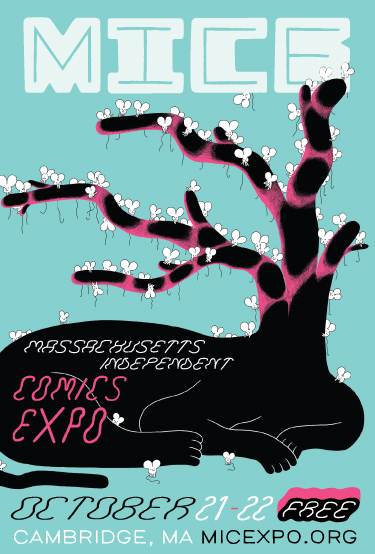Comics and Medicine Panel at MICE 2017
Posted by NNLM Region 7 on October 18th, 2017
Posted in: Graphic Medicine
Tags: graphic medicine, Teaching
Each year since 2010, the Massachusetts Independent Comics Expo (MICE) has been a showcase designed to build connections between local artists and a local audience. In addition to exhibiting artists, MICE includes workshops for both children and adults and panel discussions that delve deeper into the nuances of the medium.
This year, as part of NNLM NER’s growing Graphic Medicine initiative, I have worked together with the MICE team’s programming coordinators to coordinate a panel titled ‘Comics and Medicine’. The panel will take place at 11 am EST on Saturday, October 21st. The full description reads: “Medicine and public health are increasingly turning to comics as tools for teaching, storytelling, and more. This panel will talk about aspects of “graphic medicine”, including projects rooted in health education, medical history, and library science.”
Panelists include:
- Cathy Leamy (@metrokitty; metrokitty.com), a medical writer and cartoonist with an interest in preventive medicine and primary care.
- Kriota Willberg (@Kriota; kriotawelt.blogspot.com), whose comics focus on bodies (human and animal), anatomy, bio-science, women’s health, and history. Her self-care comics for artists will be published by Uncivilized Books as one book in April 2017. You can find her work in SubCultures, Awesome Possum 3, 4Panel.com, Strumpet5, Comics for Choice, Intima: Journal of Narrative Medicine, Broken Pencil, and the upcoming Graphic Canon. Willberg is a massage therapist and a health science educator. She is the first-ever Artist-in-Residence at the New York Academy of Medicine Library.
- Iasmin Omar Ata (@DELTAHEAD_; iasminomarata.com), an inter-sectional comics artist, illustrator, and game designer. They focus on creating art centered around the themes of coping with illness, understanding identity, and dismantling oppressive structures.
- Matthew Noe (@NoetheMatt; graphiclibrarian.wordpress.com), is a Library Fellow at the University of Massachusetts Medical School, Lamar Soutter Library and the Graphic Medicine Specialist for the National Network of Libraries of Medicine, New England Region. His specialty areas include health literacy, medical humanities, and graphic medicine. He is the curator for the weekly blog posts, ‘This Week in Graphic Medicine’, which serve as a newsletter/bibliography for comics and medicine news.
The panel will be recorded and made publicly available, but for those nearby, I encourage you to come out to MICE – not just to get direct contact with this panel, but to meet and a wide array of brilliant artists. And, of course, find new things to read!
More information about the panel, and MICE 2017 generally, including location, schedule, and a list of exhibitors, visit www.micexpo.org.
In anticipation of this panel, I asked each panelist to say in a few sentences what graphic medicine is to them. Here are their responses – a bit of a teaser of the panel to come!
- Cathy: Graphic medicine is anything involving comics/cartooning and health and illness. I love that it’s not rigid and nailed down; the door is open for all kinds of explorations and investigators. Health education comics, illness memoirs, analysis of comics for medical themes, art therapy, teaching self-expression and empathy through comics making – so many applications are possible, and we all benefit from the cross-pollination of being exposed to them.
- Kriota: My goal as a cartoonist making GM is to normalize medicine and the body. I hope to make illness, anatomy, and science a benign and familiar trio of actors in our lives, thereby mitigating the anxiety and confusion that often effects patients and their families, and stigmatizes the ill.
- Iasmin: [To me, graphic medicine is] using unique mediums to heal through the power of art. Particularly in comics and games, there exists such an opportunity for those with illness to speak, be heard, listen, and heal.
- Matthew: Graphic medicine, beyond the strict definitions and the difficult task of reigning in what exactly it means to be a comic, is about communication. Patients communicating with physicians. Physicians communicating with patients. Family communicating with family. Comics can give voice to the voiceless, clarity to the unclear, and can help us refocus medicine on the human.

— Matthew Noe —
 ABOUT NNLM Region 7
ABOUT NNLM Region 7
Network National of Libraries of Medicine, Region 7
Email author
View all posts by NNLM Region 7

